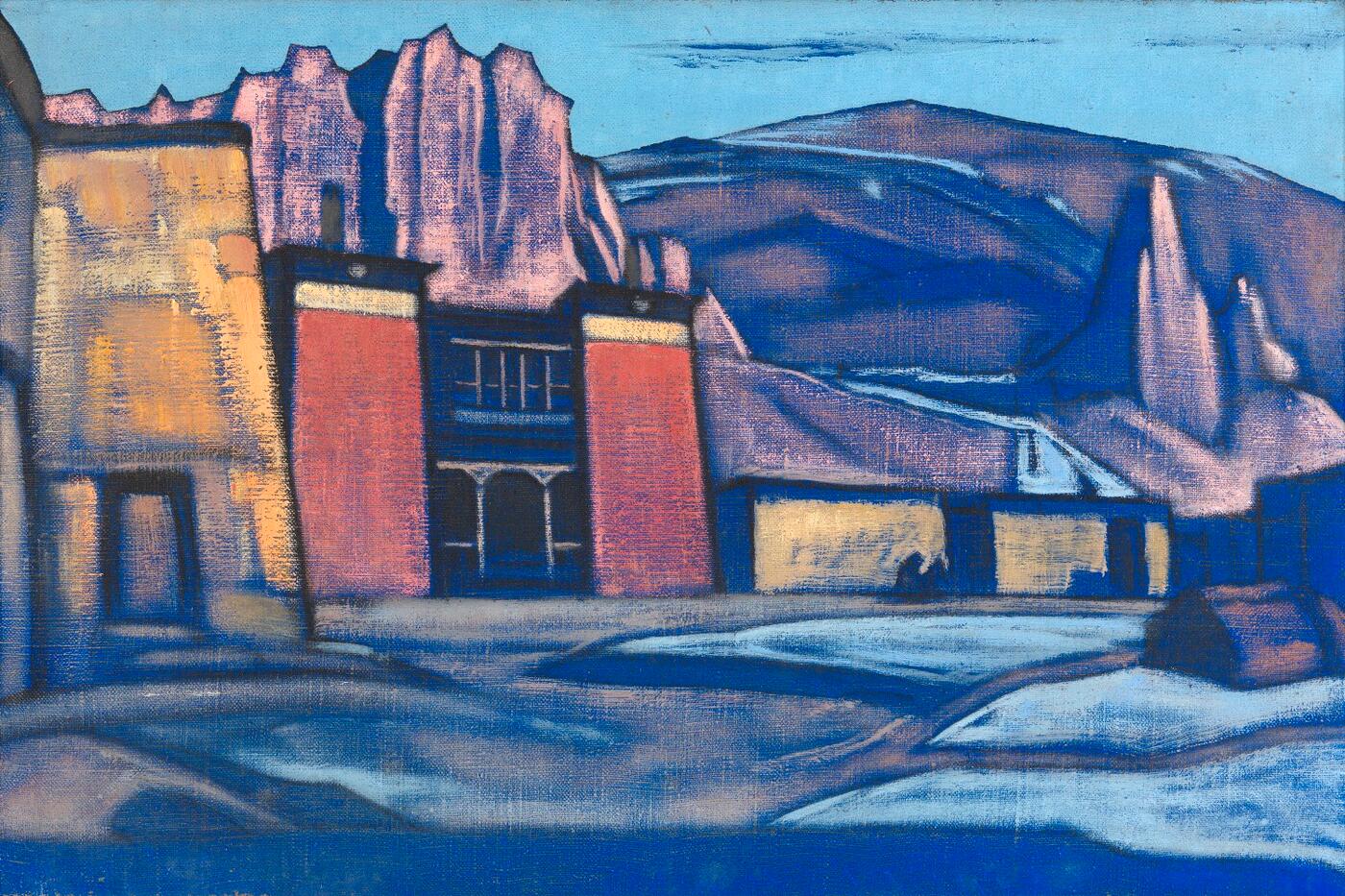25 - 28 November 2012 Russian Art Auctions
25 November 2012

* 11. ROERICH, NICHOLAS (1874–1947)
Sharugön, numbered “N33” and dated 1928 on the reverse.
Tempera on canvas, 51 by 76.5 cm.
380,000–600,000 GBP
Provenance: Roerich Museum, New York, 1928–1935.
Collection of Nettie and Louis Horch, New York, from 1935.
Acquired from the above by the present owner.
Exhibited: Roerich Museum, New York (permanent exhibition), 1928–1935, No. 863.
Literature: Roerich Museum Catalogue, 8th ed., New York, 1930, p. 34, No. 863.
N. Roerich, Altai-Himalaya, New York, F.A. Stokes Company, 1929, p. 376, illustrated in black and white.
Nicholas Roerich painted the Tibetan Bön-po monastery at Sharugön about a dozen times. (The last time was as late as 1945). The present lot is the only painting in which the monastery is presented from close range. Roerich completed this work in 1928 in Darjeeling, where he rested after his Central Asian Expedition, which saw him crossing Mongolia and Tibet from north to south. Sharugön monastery was connected with the most tragic phase of the expedition. In October of 1927, soon after crossing the Tibetan border, about 200 miles north of Lhassa, the expedition was detained by the Tibetan Government. Nicholas Roerich later wrote: “… instead of three days we remained in this dull place, at 15,000 [feet], for five months. The situation became catastrophic. A severe winter set in, with whirlwinds and snow. What had happened, and where, we could not discover, for all letters sent by us to the Dalai Lama and the Governor of Nagchu, were returned to us and often torn up. … [We] were refused permission either to go forward or back, as if they actually wished our destruction. Our money was exhausted. Of course the American dollars which we had with us were absolutely useless. Moreover, we had no more medicine and our provisions were at an end. Under our very eyes, the whole caravan perished. Each night the freezing, starved animals approached our tents, as though knocking for the last time before their death. And in the morning we found them dead, near our tents. Our Mongols dragged them beyond the camp, where packs of wild dogs and condors and vultures were already awaiting their prey. Of a hundred-and-two animals, we lost ninety-two. On the Tibetan uplands, we also left the bodies of five of our fellow-travelers: three lamas, one Buriat and two Mongols… Our caravan had only summer tents, as we never imagined we would pass the winter in Changthang, which is considered the most severe site in Asia.” (Nicholas Roerich, Heart of Asia).
The expedition spent part of the detention, from mid-December to mid-January, near the Bön-po Sharugön monastery. Roerich wrote: “… speaking of religions in Tibet, one should mention also the Black Faith, inimical to Buddha. …in addition to the Gelugpa, the Red Cap Sect of Padma Sambhava, … the Bon-po or Black Faith is also spread considerably in Tibet. … We saw a great many monasteries of the Bon-po in different parts of Tibet. They all are apparently very wealthy. In Sharugen we were received most cordially in the Bon-po monastery, and were even admitted into the temple and shown the sacred books. It was proposed to George that he read them. But then suddenly their attitude changed. It appeared that the Bon-po had heard of our interest in Buddhism and therefore regarded us as their enemies. The Bon-po say that the Buddhists are their enemies. Buddha is not recognized and the Dalai Lama is considered only a temporal ruler. The ceremonials are conducted in a way precisely contrary to those of the Buddhists. The sign of the Swastika is represented in an inverted direction. The processions in the temple walk away from the sun. Instead of Buddha, another protector is represented, whose biography coincides strangely with the narratives of Buddha’s life. The Bon-po have their own sacred books. It is a pity that the literature of the Black Faith has been studied so little and that their sacred books have not yet been translated. One cannot refer to these ancient traditions lightly, when they speak of their mysterious ‘Gods of Swastika’. The ancient solar and fire cults undoubtedly are the basis of Bon-po, and one must carefully examine these old, half-erased signs.” (Nicholas Roerich, Heart of Asia).
All the hardships notwithstanding, with temperatures at night constantly dropping below -30°C, the Roerichs still managed to pursue the scientific goals of the expedition. None of Roerich’s numerous Sharugön paintings carry even the slightest hint that the expedition almost perished here. To Roerich, this monastery is yet another symbol of the power of spirit over physical circumstances. Photographs of this area show a bleak scenery and shabby building, but Roerich endows this moment with monumental clarity. The bronze and gold glow of the monastery stands out among the cool blue tones of the mountains, suggesting that the spiritual lore transforms even the harshest environment. The mingling of blues, reds, and yellows capture the two extremes of nature in the mountains: unforgiving frost and flaming light. From the point of view of intensity of colors this is probably the most rich and elaborate canvas that Roerich painted in 1928 right after the expedition, making it one of the most interesting works of this period.
We are grateful to Gvido Trepša, Senior researcher at the Nicholas Roerich Museum, New York, for providing catalogue information
Notes on symbols:
* Indicates 5% Import Duty Charge applies.
Ω Indicates 20% Import Duty Charge applies.
§ Indicates Artist's Resale Right applies.
† Indicates Standard VAT scheme applies, and the rate of 20% VAT will be charged on both hammer price and premium.